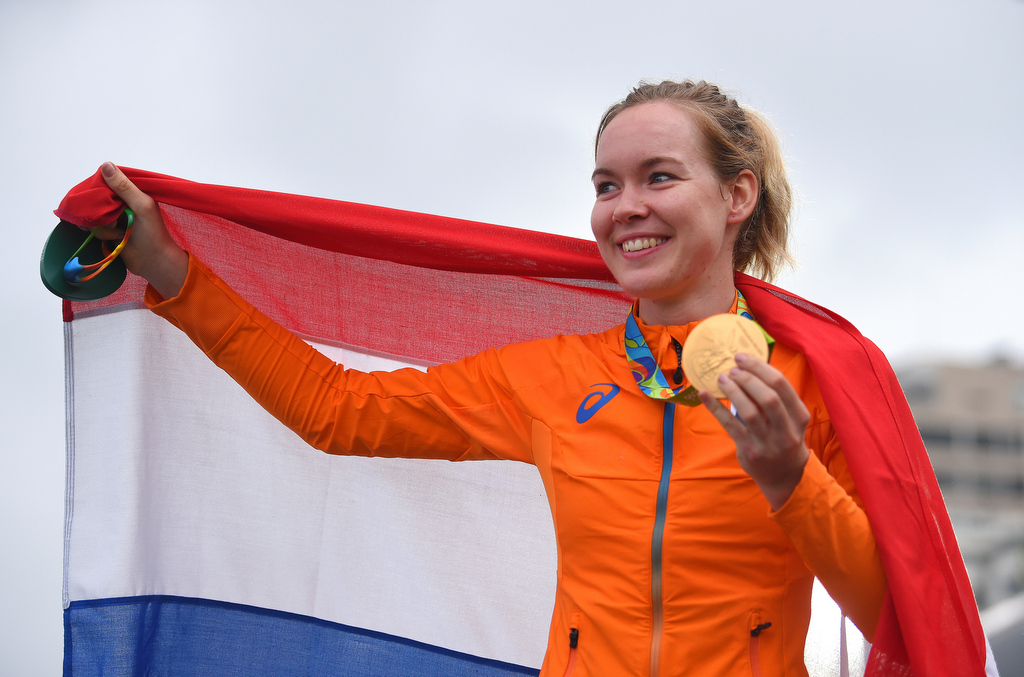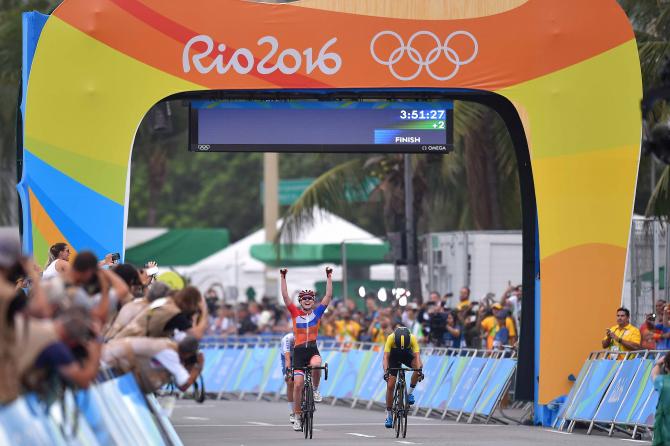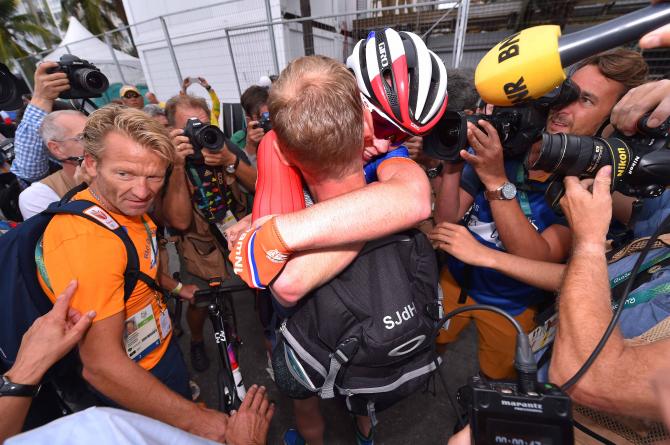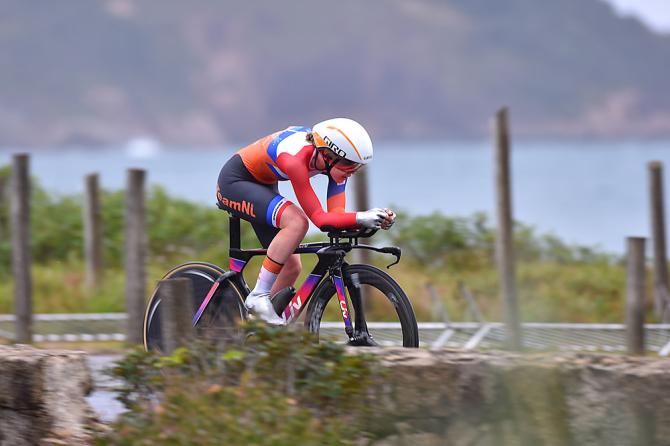The Golden Girl: Anna van der Breggen
Procycling's full interview with the Olympic champion

This article first appeared in the October 2016 edition of Procycling magazine.
A more disruptive, terrifying race scenario for a competitor in an event on the scale and importance of the Olympics would be difficult to concoct. You round a blind corner on a descent and see your team-mate face down, motionless and crumpled in a ditch. You search for clues of life. Nothing. There’s a bystander beside her, doing nothing. You think the worst. You think they’re dead.
What do you do? That single, chilling frame of the limp, unconscious Annemiek Van Vleuten filled the minds of Anna van der Breggen and co-pursuers Emma Johansson and Elisa Longho Borghini as they rode past the stricken 33-year-old, just as it did the millions who watched the women’s Olympic road race on TV.
“Annemiek was just lying there in a really strange way,” Van der Breggen recalls to Procycling. “I don’t know why but I thought Annemiek was dead because otherwise the guy would do something – sit next to her, talk to her, do anything. But she was just lying there.”
Van der Breggen is recounting this three weeks later. As she talks, she’s being driven back from a celebratory garden party with the Dutch Olympic team at The Hague. There, in the courtyard at the Noordeinde Palace, honoured by king and queen, she wore two medals: one bronze for the time trial, one gold from the road race. Most importantly, Van Vleuten, de facto tutor to Van der Breggen and a former room-mate for two years while both were at Rabobank, is returning to full health. The good times are rolling but to Van der Breggen the events of Rio are still visceral. It’s as if she is determined not to let the memory fade away by simply going through the motions.
“You’re thinking about all these things in the next few kilometres,” she continues, her mind back in the closing kilometres of the race of her life. “We were going pretty slowly for a while afterwards or at least I wasn’t really contributing. Then I realised I’m doing a race and that I’m now the first in the team. There was nothing I could do for Annemiek anyway.”
But the real psychological kick came when Johansson rode up beside her and said, “Come on, we have to do the ride; do it for Annemiek.”
Get The Leadout Newsletter
The latest race content, interviews, features, reviews and expert buying guides, direct to your inbox!
“If somebody says something, you think again about the race,” said Van der Breggen. “You’re not left with your own thoughts about what you saw anymore. My refocus would have come back I think even if Emma didn’t say anything but yeah, maybe it helped. It was special that Emma said it. It says a lot about what kind of rider she is.”

By the time the race reached its finale by the Copacabana beach, Van der Breggen’s mind was back on the task in hand and she took the win. Her palmarès now stands as one of the most complete in the women’s peloton. The Olympic medals head a list of wins that include the Giro Rosa, La Flèche Wallonne twice, Omloop Het Nieuwsblad, and the Elsy Jacobs Tour twice. Last year was her greatest season and she finished it as the number one ranked rider. Such a body of work is more than the product of fine form – it need to be allied to a rare competitive ferocity. The rather single-minded quality that helps separate the good from the great emerged when it mattered: after she saw Van Vleuten lying unconscious beside the road; it just needing coaxing out.
“On the race day I was nervous because the whole season I’d focused on this. You know you only have one chance in four years and so it’s very special. Then you wake up and you realise today’s the day but then I also thought, I’ll go to bed when it’s finished, no matter what happens. It’s also a day like any other.”
Van der Breggen, the pre-race favourite, led the strongest team in the race. It included Ellen Van Dijk, Marianne Vos and Van Vleuten. “Four riders is nothing, though, and it’s impossible to really control the race. And we had no communication, of course,” says Van Der Breggen. Nevertheless, the Dutch played the race perfectly. Van Dijk and Vos marshalled the front of the race in the early stages. Their initial plan had been to try and split the field on the cobbles but when the Germans tried to work with the wind on the flat stretches they knew there was no point and they settled in to wait for the Vista Chinesa.
The only real off-script turn the race took for the Dutch was that Van Vleuten proved the strongest rider in the race. “To climb how she did, Annemiek surprised me – and not only me, also the rest of the riders and also the world,” says Van der Breggen. And without the crash, Van Vleuten would surely have won. More powerful on the flat than her rival, Mara Abbott, the threat would have been from Johannson and Longo Borghini.
It was a testament to the depth of the Dutch team that on the Vista Chinesa they had a team-mate in three of the first four groups over the summit. So when Van Vleuten badly misjudged the corner near the bottom while a long way in the lead, Van der Breggen, who had no idea of time gaps or what lay around the corner further down was ideally placed to take control.
After Johansson’s intervention, Van der Breggen says she was never sure the pursuit would catch Abbott, the American pure climber who tottered down the Vista Chinesa after Van Vleuten. The American support car was briefly inserted, Van der Breggen remembers, suggesting the gap was at least a minute and it came down more slowly than most expected. The trio worked smoothly to start with before Longo Borghini, a trade team-mate of Johansson, did the lion’s share of the work as the race hit the coast. “That saved us,” Van Der Breggen admits. It also allowed her to sit in the wheels and figure out how to beat Johansson, on paper a stronger sprinter.
The second agonisingly compelling moment of the race occurred when Abbott was caught within sight of the line: excruciating for the American, glorious for the three chasers who shared the medals. “When I crossed the finish line my mind was in the race. I realised I’d won the Olympics,” Van der Breggen recalls. “That was the first victory moment but directly after I wanted to know how Annemiek was because I really thought she might have been dead.
“The whole race wouldn’t have meant anything. My first question to my boyfriend and soigneur was, ‘How is Annemiek?’ He said she looked okay and she was conscious and in the ambulance. After that I could let myself think that I’d won the Olympics.”
“It was pretty difficult to refocus,” Van Der Breggen admits. “Not because I had won the Olympics but the story with Annemiek. You know that she was so close and that maybe she was going to win it. But you feel for yourself as well. You know what you did for this race.”

The time trial two days later was the ready-made diversion she needed from emotions that surely edged towards guilt. All year, Van der Breggen said she had been working towards the TT with as much attention as the road race. Second in the Giro’s major TT behind Evelyn Stevens proved she had the form. Again, she was named as a pre-race favourite for the gold.
That status was complicated by the will-she-won’t-she-be-allowed-to-race saga that embroiled Russian rider Olga Zabelinskaya. Despite serving an 18-month doping ban which ended in April, and the general controversy around Russian athletes following the exposure of state assisted doping in the McLaren Report, she was cleared to race both the road and TT. In the time trial, the Russian finished second, improving on her third place in London. Kristin Armstrong, the American veteran, was first and set a new record as the first cyclist to win three golds in the same discipline. Her participation was not without controversy either, having been selected for the American team without contributing to the qualification process. Van der Breggen was third.
“We were surprised when we heard Zabelinskaya was riding for the road race,” Van der Breggen confirms. “But before a time trial I always say I don’t care who is riding. That’s the easy thing about the TT – it’s me and my bike. I have to do it all.” Asked if she feels frustrated, or worse, cheated, the first plaintive strains of exasperation emerge. “You can say a lot of things about the ones who are in front but that day, at that moment they were faster than me in that time trial,” she starts. “You cannot change it. They were that good that day and you can say it’s special because the whole season they were not that good but maybe they were really looking forward to this moment and they had really good timing and a good day.
“I don’t know what they did or what they thought. I think it’s the easiest just to think about the things you can change. I can be really angry and ask questions but it’s not going to change anything. I don’t want to waste energy on that.”

The Olympics have gilded Van der Breggen’s status as the most versatile all-rounder in the peloton. The medals confirmed she is the natural successor to her current team-mate, the incomparable Marianne Vos. Two medals at the same games also echoes the insurmountable achievement of her compatriot Leontien Van Moorsel, who took gold in the road race, time trial and individual pursuit in Sydney in 2000. In short, Van der Breggen, at 26, with her best years ahead, is shaping up to be one of the sport’s greats.
But change is on the horizon for Van der Breggen. Next year she will ride for Boels-Dolmans. It’s a formidable thought, for she will be joining the strongest and deepest squad in the peloton. There could be an element of jockeying for position as she splits leadership with Lizzie Armitstead and this year’s most consistent rider, Megan Guarnier. But she’s looking forward to the challenge.
“I’ve had three really good years with this team and I’m really thankful for that but now I have the opportunity to change from one good team to another,” she says as the interview winds down. “I like to experience new things, so to ride in a new environment, with new people and on different equipment, is something I’m looking forward to.” And if she shows anything like the composure that she showed in the eight-month build-up to four rollercoaster days in Rio, it’s hard to imagine she’ll miss a beat.
To subscribe to Procycling, click here.
Sam started as a trainee reporter on daily newspapers in the UK before moving to South Africa where he contributed to national cycling magazine Ride for three years. After moving back to the UK he joined Procycling as a staff writer in November 2010.